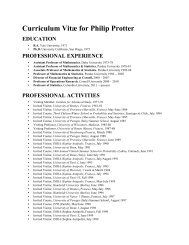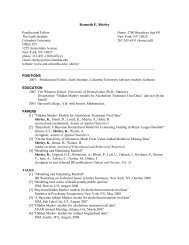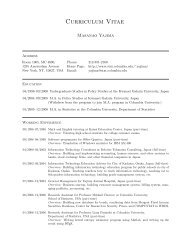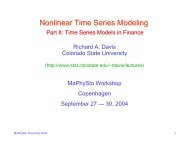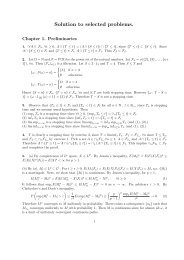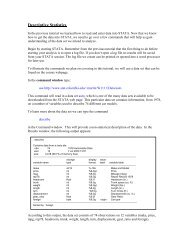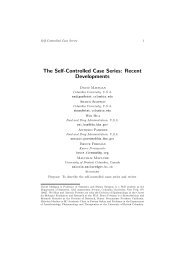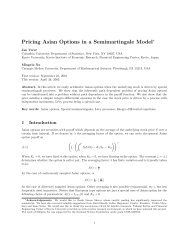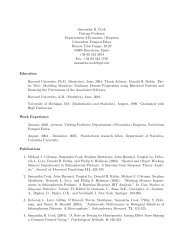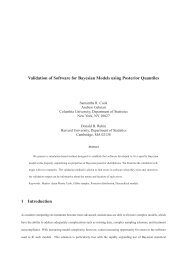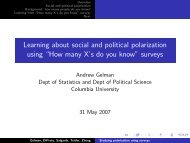sinning in the basement: what are the rules? the ten commandments ...
sinning in the basement: what are the rules? the ten commandments ...
sinning in the basement: what are the rules? the ten commandments ...
You also want an ePaper? Increase the reach of your titles
YUMPU automatically turns print PDFs into web optimized ePapers that Google loves.
APPLIED ECONOMETRICS 571<br />
Mov<strong>in</strong>g down to <strong>the</strong> first floor, we f<strong>in</strong>d econometrics courses of a more<br />
elementary nature, cover<strong>in</strong>g <strong>the</strong>oretical and applied topics such as <strong>the</strong> use and<br />
<strong>in</strong>terpretation of dummy variables, <strong>the</strong> logic of F and chi-squ<strong>are</strong> tests, and test<strong>in</strong>g<br />
and correct<strong>in</strong>g for nonspherical errors. On this floor, as on <strong>the</strong> higher floors, a<br />
common compla<strong>in</strong>t (Wild, 1994; Chatfield, 1995a) is that teach<strong>in</strong>g is techniqueoriented<br />
ra<strong>the</strong>r than problem-oriented. In Bailar’s (1988, p. 7) words, <strong>in</strong>structors<br />
‘were not teach<strong>in</strong>g statistical reason<strong>in</strong>g. They were teach<strong>in</strong>g mechanical<br />
manipulations’. An exam<strong>in</strong>ation of typical econometrics textbooks does little to<br />
dispel this view — assignments <strong>in</strong> <strong>the</strong>se texts ma<strong>in</strong>ly set students up to apply a<br />
technique, ra<strong>the</strong>r than creat<strong>in</strong>g for <strong>the</strong>m a real-world scenario <strong>in</strong> which,<br />
undirected, <strong>the</strong>y must address an empirical issue.<br />
Judg<strong>in</strong>g by our econometrics textbooks, <strong>the</strong> first floor is <strong>the</strong> bottom floor of <strong>the</strong><br />
econometrics build<strong>in</strong>g — <strong>the</strong>re is no floor below this, only a separate build<strong>in</strong>g<br />
hous<strong>in</strong>g <strong>in</strong>troductory statistics courses. But <strong>what</strong> about <strong>the</strong> <strong>basement</strong> of <strong>the</strong><br />
econometrics build<strong>in</strong>g? Accord<strong>in</strong>g to Leamer, this is where real-world econometric<br />
model<strong>in</strong>g is done. Does <strong>what</strong> we teach on <strong>the</strong> upper floors adequately<br />
prep<strong>are</strong> students for work<strong>in</strong>g <strong>in</strong> <strong>the</strong> <strong>basement</strong>? One <strong>the</strong>me of this paper is that our<br />
students <strong>are</strong> not well prep<strong>are</strong>d for real-world econometric work. We do not alert<br />
<strong>the</strong>m to <strong>the</strong> true fundamentals of do<strong>in</strong>g applied work (<strong>the</strong> ‘<strong>rules</strong> for <strong>s<strong>in</strong>n<strong>in</strong>g</strong>’),<br />
prerequisites for successful application of <strong>the</strong> concepts and techniques <strong>the</strong>y learn<br />
on o<strong>the</strong>r floors.<br />
It is not hard to f<strong>in</strong>d rumbl<strong>in</strong>gs of discon<strong>ten</strong>t among applied econometricians<br />
regard<strong>in</strong>g <strong>the</strong> way <strong>in</strong> which <strong>the</strong> subject is taught. Magnus (1999, p. 60) identifies a<br />
major concern:<br />
My worry as an econometric <strong>the</strong>orist is not that <strong>the</strong>re is <strong>ten</strong>sion between us<br />
(<strong>the</strong> <strong>the</strong>orists) and <strong>the</strong>m (<strong>the</strong> applied economists). On <strong>the</strong> contrary, such<br />
<strong>ten</strong>sion can be healthy and <strong>in</strong>spir<strong>in</strong>g. My worry is ra<strong>the</strong>r <strong>the</strong> lack of <strong>ten</strong>sion.<br />
There <strong>are</strong> two camps, a gap between <strong>the</strong>m, and little communication.<br />
Magnus and Morgan (1999, p. 379) conclude that ‘There is clearly a big problem<br />
of middle-level <strong>in</strong>struction’. And Wooldridge (2000, p. iii), notes ‘There is a<br />
widen<strong>in</strong>g gap between <strong>the</strong> way <strong>in</strong> which <strong>in</strong>troductory econometrics is taught and<br />
<strong>the</strong> way empirical researchers th<strong>in</strong>k about, apply, and <strong>in</strong>terpret econometric<br />
methods’. These compla<strong>in</strong>ts <strong>are</strong> directed more at first-and second-floor activity<br />
than at <strong>basement</strong> activity. In contrast, this paper focuses on <strong>the</strong> <strong>basement</strong>,<br />
propos<strong>in</strong>g <strong>rules</strong> of applied econometrics behavior that will annoy econometricians<br />
— <strong>the</strong>y will view <strong>the</strong>se <strong>rules</strong> as ei<strong>the</strong>r unteachable 2 or so elementary that both<br />
undergraduate and graduate students surely will have learned <strong>the</strong>m at an earlier<br />
stage <strong>in</strong> <strong>the</strong>ir academic c<strong>are</strong>er. Readers can judge <strong>the</strong> former issue for <strong>the</strong>mselves;<br />
my op<strong>in</strong>ion is that regardless of teachability, we have a moral obligation to <strong>in</strong>form<br />
students of <strong>the</strong>se <strong>rules</strong>, and, through suitable assignments, socialize <strong>the</strong>m to<br />
<strong>in</strong>corporate <strong>the</strong>m <strong>in</strong>to <strong>the</strong> standard operat<strong>in</strong>g procedures <strong>the</strong>y follow when do<strong>in</strong>g<br />
empirical work. On <strong>the</strong> latter issue, my many years of experience teach<strong>in</strong>g,<br />
practic<strong>in</strong>g, supervis<strong>in</strong>g, referee<strong>in</strong>g and edit<strong>in</strong>g applied econometrics (but not my<br />
read<strong>in</strong>g of econometrics textbooks!) have led me to believe that <strong>the</strong>se <strong>rules</strong> <strong>are</strong> far<br />
# Blackwell Publishers Ltd. 2002



